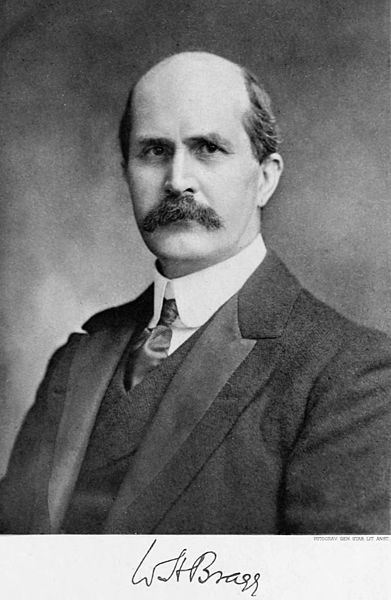A mineral of history – Fluorite

William Henry Bragg’s portrait on winning the Nobel Prize. Image from the Nobel Foundation.
Today would have been the 152nd birthday of one of the founders of crystallography, William Henry Bragg. Together with his son W. L. Bragg, he won the 1915 Nobel Prize in physics. Between this work and the work of the previous year's Nobel Prize won by Max von Laue, these researchers put down the rules for us to discover how atoms are arranged in solids.
After finishing his PhD with J. J. Thomson (the man who discovered the electron) W. H. Bragg journeyed to Australia, where at the age of 23 he became a professor of physics at Adelaide University. Here he also married Gwendoline Todd, the daughter of Charles and Alice Todd (after whom Alice Springs is named), and their first son William Lawrence was born.
The family moved to the UK in 1909, W. H. Bragg to take up a position at the University of Leeds, and W.L. Bragg to continue his university studies at Cambridge. It was during this time that they both worked on the equation that was to bear their name, and the research that would earn them a Nobel Prize.
We've already covered the mineral Braggite, named after W. H. and W. L. Bragg – so instead today we thought we'd cover one of the first crystal structures they worked out, Fluorite.
What does it look like?
So far this year we come across many ways to represent crystal structures. This may be the most original yet!
What is it?
Calcium Fluoride, CaF2 or Fluorite, is a colourful mineral that is found all over the world. It comes in a large range of colours, from green through to dark purple, all dependent on the small amount of element impurities contained within it. Given the right impurities, it will also fluoresce under UV light – the name of this property actually takes its name from fluorite.
In working out the structure of fluorite, the Braggs noted the similarity of its diffraction to that of diamond. From this they could work out that the atoms would be similarly arranged - but with gaps, as there isn't a 1 to 1 ratio of fluorine atoms to calcium atoms.
Where did the structure come from?
Like the rock salt structure, you can read about how this structure was discovered straight from the book 'X-rays and crystal structure' by W. H. and W. L. Bragg.






